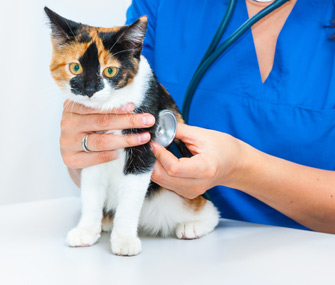Help Make Your Cat’s Next Vet Visit Fear Free
Published on September 21, 2015
Skip To

Fear Free veterinary care is a major movement sweeping through the veterinary profession. The goal is to reduce animals’ fear of veterinary visits by employing strategies that start at home, including training and medication, and extend through the pet’s visit to the clinic or hospital. Veterinarians and staff at Fear Free clinics work with pet owners to take the stress out of medical care — for pets and people.
It’s All About Collaboration
There are some simple strategies you can use to determine if a clinic adheres to the Fear Free approach. Start by asking your current clinic how you can work together to alleviate your cat’s anxiety, from helping you prepare your cat for her appointment to keeping her stress levels low throughout the entire visit, including any treatments or procedures. Ask about the staff’s strategies for interacting with anxious cats, particularly in relation to handling and medication. Another option is to search for a veterinarian or practice that is Fear Free certified. If your cat is particularly anxious in specific situations (having her paws touched, for example), it’s helpful to relay such information to the staff, so they can take extra care in their approach. By the same token, if there are certain ways of being handled, petted or examined that your cat either responds to or resists, share that with the clinic staff.
Be clear with the staff about your cat’s specific issues, as well as any strategies that have — or have not — worked in the past. Ideally, you would do this before your cat’s visit, but don’t be afraid to speak up during the appointment.
Once the clinic staff knows your concerns, they may be able to take other measures as well, such as scheduling your appointment during slow periods or booking back-to-back appointments for your cat, so the exam can be performed at a more leisurely pace. This type of arrangement can help alleviate your cat’s anxiety and is well worth any extra cost you may incur.
Some Fear Free Strategies
There are a number of ways a
clinic can work with you to address your
feline’s fears. For instance, if waiting in the lobby is stressful for
your cat, a different option may be available, such as allowing you to
take her immediately into an exam room or allowing you to wait in the
car with your cat until the vet is ready to see her. Or if your cat
tends to hide when she first enters the exam room, ask the staff if you
can have a little extra time before the vet or staff joins you to give
her a chance to get comfortable before her exam.Another way to help your kitty feel less afraid is to pack a bag with the things she loves. Favorite bedding, toys and treats are all good things to bring with you and have available for the clinic staff to offer your cat during her visit. Unless it is contraindicated by the pet’s medical situation, many clinics may be willing to incorporate positive rewards, like a treat or favorite toy, either during or after handling and procedures.
Many offices are also happy to accommodate requests for things a cat particularly enjoys, such as a warm blanket on the exam table or scale. The vet may also be willing to examine your feline in her crate rather than on the exam table.
You can also ask the staff about the possibility of dropping in for fun visits in between your scheduled appointments to allow your feline to have a positive, procedure-free experience at the clinic. Talk with the vet and her staff about what options are available for your fearful feline.
Other Alternatives
No matter how gentle the approach, your cat’s fear may be too great to be overcome with familiar treats or modifications to clinic routine. In such cases, your veterinarian may recommend medications to help manage your cat’s anxiety and promote relaxation. This approach may involve giving your cat certain medications at home before you leave for the clinic; if needed, additional medications may be added during the visit to keep your cat calm and relaxed during her exam or any necessary treatment.Extremely anxious cats may fare better at a feline-only practice where they won’t meet up with curious dogs in the waiting area, or with a veterinarian who makes house calls in the environment that’s most familiar and comfortable for you cat.
A partnership with a veterinary staff who are committed to investing in your cat’s emotional health is powerful. Rather than resolving to a feline being a perpetual scaredy-cat at the vet, there are numerous ways to help, starting with collaboration with your vet.
More on Vetstreet:





